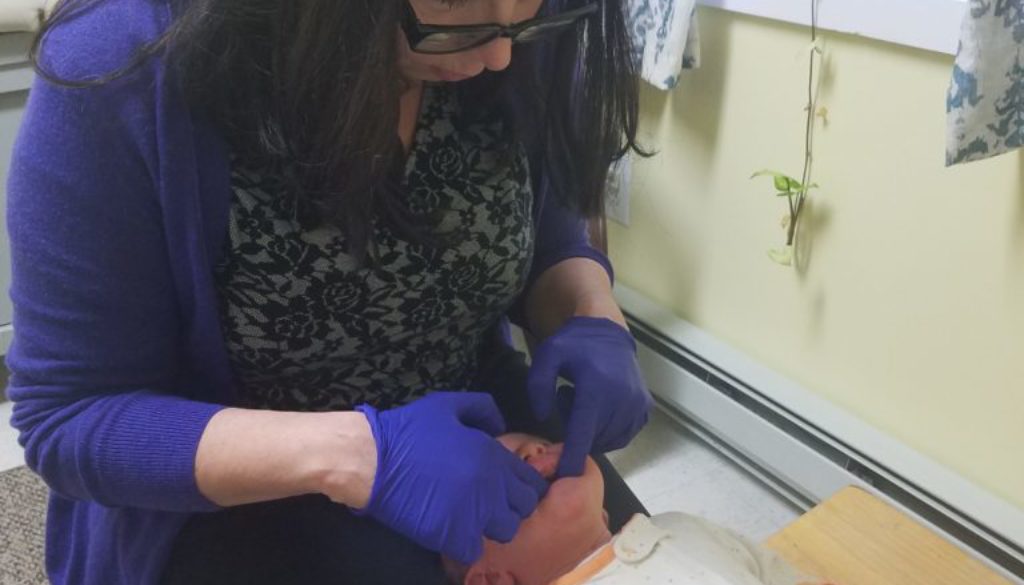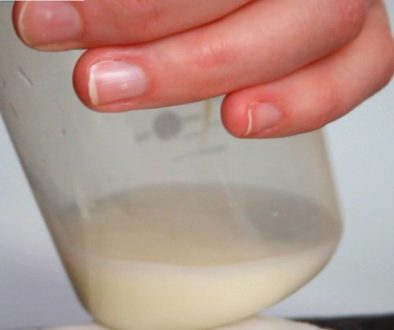Tongue and Lip Tie: An Introduction and Overview
Click to learn more: Tongue Tie Course
I see so many babies who have trouble breastfeeding due to oral restrictions, including lip, tongue and even buccal (inner cheek) ties. As a lactation consultant, I diagnose this issue almost daily. Revealing these restrictions often brings confusion for parents. Many times this is the first they are hearing about oral restrictions and revealing that their baby has a problem can cause some distress. For those of you who have a child who is diagnosed, or for other curious parents who are wondering if their symptoms are related to tongue tie, I will try to explain this condition, in plain language. I will also discuss how it is diagnosed, and what medical providers to seek out when these issues arise.
A frenum is the tissue that attaches the tongue to the bottom of the mouth. The frenum can either be too short or attached too far forward in the mouth to allow proper movement of the tongue for breastfeeding. There is also a frenum that attaches the lips to the gums. If this is too tight, the lip can’t “flange” to enable a comfortable and efficient latch for breastfeeding. Frenums can also be found further back along the gum line, attaching to the cheek, causing difficulty opening the mouth and using the cheek muscles to transfer milk. These are called buccal ties.
Tongue, lip and buccal ties are also referred to as tethered oral tissues. Tethered oral tissues can prevent babies from latching or can cause nipple pain and damage when the latch is poor. Often the first sign is painful breastfeeding. Another early sign is a baby who isn’t gaining or nursing enough to bring mom’s milk in. This can result in dehydration or jaundice and need for supplementation with a breast milk substitute. Sometimes mom gets through this painful feeding, and infant compensates at the breast in ways that cause an oversupply of milk for mom. These babies do well until they don’t. There comes a time when milk supply becomes more dependent on baby nursing efficiently. Babies with ties need to work really hard to get milk to come down, and some babies can’t keep up with the compensations and start to lose weight. Their inefficient nursing sets up a cycle that decreases mom’s supply, because breastfeeding is a delicate dance of supply and demand.
Some babies work so hard at the breast that they burn more calories that they take in when they are feeding. These are the babies that “nurse all the time” but don’t gain adequate weight. They are often labeled as “colic” but it’s true hunger that is making them cry. Moms report not being able to put the baby down or feedings going on forever. That is because the baby is taking “sips” at a time, all day long, not a feeding that satisfies for any amount of time.
Another possible scenario is the baby who seems to nurse without difficulty, but exhibits signs of colic or reflux. Both colic and reflux can be a result of swallowing too much air. With tethered oral tissues, the lip and tongue can’t work as they are meant to, and the way the baby compensates can allow air to be taken in. These babies are often noisy eaters who appear to slide on and off the breast or may make a clicking sound while eating.
Sometimes the mom and baby feed without too much issue, but when a bottle or solids are added, infant may have difficulty due to restrictions.
Diagnosis of tongue and lip tie is both a structural and functional assessment. It is not enough to examine the mouth or look at a picture taken. It is vital to know what the tongue and lip can do while nursing or bottle feeding, or for older children, chewing and swallowing. The IBCLC who is trained to recognize how these restrictions affect latch, suck, swallow and breathing is the best advocate to have on your side when issues arise. She can recommend how to treat the restrictions and what other supportive therapies may be needed. Body work such as chiropractic or craniosacral therapy, is often necessary and helpful to relax the muscular structures and align the body in preparation for the revision. Proper body work prepares the body to adjust to the release of the tongue and prevents reattachment, which is the most common complication of the procedure to release the attachments.
Selecting a practitioner for the procedure is an important decision. There are a small, but growing number of doctors who have learned to diagnose and treat tongue tie because the recognition of tongue ties in medical education is limited to finding the most obvious ties that occur close to the front of the tongue. There are some doctors and dentists that have become experts in this field through experience, continued education, networking and research. Your pediatrician may not be familiar with who to refer you to and, in most cases, is not the expert on infant feeding to rely on for the last word on your situation.
The actual procedure may be done with laser or scissor. There are providers who are proficient in each. I like to refer to providers who are comfortable with laser release, because in my experience these releases are more complete and I have seen better result.
If the provider doesn’t ask you to work with an IBCLC, then he/she probably doesn’t understand the role of the tongue/lip and breastfeeding. It is rare that just revising the tissue solves all of the problems with breastfeeding and it bears repeating that working with an IBCLC is vital for your breastfeeding success.
Only an IBCLC can help you with milk transfer issues, best position for latch for your baby, and how to know if your baby is getting enough milk from you. If supplementing is necessary, she will guide you to the optimal way for your situation, how much to supplement and how to increase your milk supply while you are supplementing.
She will guide you with exercises that are recommended before and after the procedure, both to prevent the sites from healing too fast, and to help the baby learn to use his tongue once it is free from the tether. She can refer you to providers to help with other issues as she sees necessary.
This may be a simple fix or it may be a complicated journey to healing. It is possible to “do everything right” and still have reattachment. Some babies heal so fast that the cut heals closed instead of in its new position. Some babies improve immediately, some have an adjustment time with a series of ups and downs before things become easy. Sometimes the release needs to be repeated. Sometimes, body work will help things get on the right path. There is little means to predict the course, only support to give along the way.
I am passionate about this topic because every baby that I see who I see having difficulty with breastfeeding, has some sort of restriction. Sometimes, changes in the position or management of feeding along with some body work can appear to get breastfeeding to work easier for the couplet, but more often than not, more is needed to optimize the feeding relationship.
I have attended countless hours of education on this topic in the past few years, and still feel that there is so much more to learn. The body of evidence on this topic is growing, but is still lacking. Those of us who are at the forefront, working with moms and babies on a regular basis, have formed organizations around the topic, trying to learn from each other’s experience, and research.
I have worked with hundreds of families whose babies have tethered oral tissues causing breastfeeding concerns. Most have had the release procedure, some have not. Either way, I respect the commitment and dedication of the families that I am privileged to serve. The reward of knowing that our treatment plans have assisted moms to reach their personal feeding goals is priceless.
After reading this, I hope that you have a better understanding of oral restrictions and how they affect infant feeding, what to do if your baby has symptoms of oral restrictions, and how important an IBCLC is in managing treatment in these cases.
Click here for free download: Symptoms of Lip & Tongue Tie






